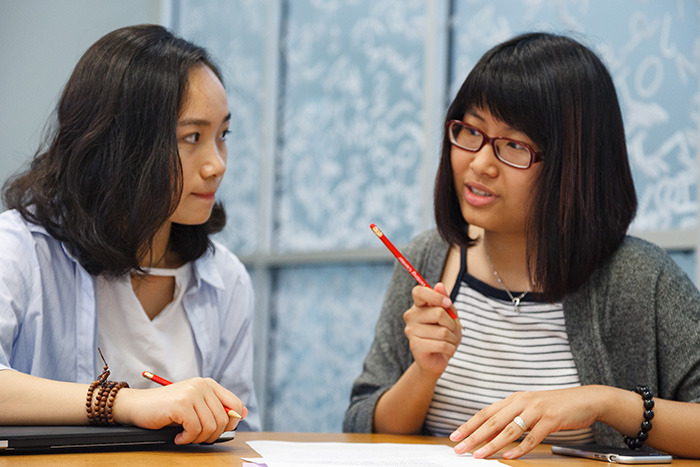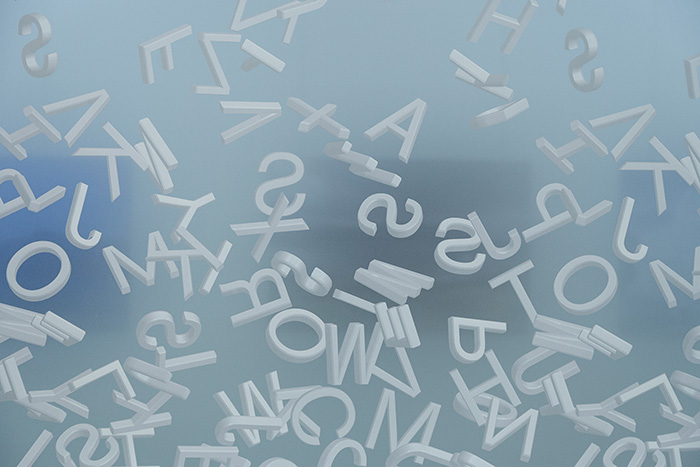Futuristic Spaces

Photo by Carl Socolow '77.
New spaces on campus help students master skills for an information age
by MaryAlice Bitts-Jackson
Letters or numbers? Chances are, you have a clear preference. But in an information age, quantitative reasoning, language and writing are all essential tools. Now there’s a dedicated spot on campus where students can help each other build on, and connect the dots between, the crucial skills they’re learning in class.
Housed across the hall from one another on the first floor of the Waidner-Spahr Library, Dickinson’s new Quantitative Reasoning (QR) Center and the revamped Norman J. Eberly Multilingual Writing Center take an integrated approach to writing, language acquisition and numerical literacy, offering students peer-to-peer support that crosses linguistic, cultural and disciplinary boundaries.
New tenants, new vibe
The cross-fluency begins in the Writing Center, established in 2005 in honor of Norman M. Eberly ’24, which offers culturally targeted writing instruction in English and 10 other languages. In past years, the English-language tutors worked on the main floor of the library, while the foreign-language tutors were based in the building’s lower level. A recent redesign—funded by Eberly’s son and daughter-in-law, Joe and Shirley Eberly—brings all of the tutors together in the same space.
“That’s revolutionized our Writing Center, because our English-language and foreign-language peer tutors can more easily learn from each other,” says Noreen Lape, director of the writing program, noting that the center serves not just U.S. and foreign-born students alike but also international scholars and international fellows from the neighboring U.S. Army War College.
And for tutors like Rinaldys Castillo ’17 (biochemistry & molecular biology), a Spanish-language tutor, the collaborative lessons are already underway.
“It’s incredible to be able to provide students not only with the grammatical rules they need [to write effectively in a second, third or fourth language] but also the deep cultural meaning behind those words,” says Castillo, who well understands the importance of cultural context in language acquisition, having come to America with his family at age 13.

Photo by Carl Socolow '77.
The center’s design reflects its forward-thinking ethos and energy: The outer walls are festooned with frosted letters, creating a private yet light-filled common work area. Step inside, and you’ll find brightly colored, easily movable furniture and chalkboard surfaces for brainstorming. High-efficiency suspension lighting completes the look and showcases original artwork, curated by former tutor Joelle Cicak ’16, the art department’s post-baccalaureate artist-in-residence, and by Taylor Hunkins ’17, a Trout Gallery intern and tutor. Most of the works are by past and present tutors.
Gem among gems
The modernist vibe continues at the QR Center, where numbers cascade down the etched-glass walls. Funded by a $115,000 grant awarded last spring by the George I. Alden Trust, the QR Center also features whiteboard-surface tables and azure chairs on wheels, inviting reconfiguration and collaboration.
In its pilot year, the QR Center is open weekday evenings and for four hours over the weekend. It has eight tutors on staff, each trained by Lape and Sarah Niebler, assistant professor of political science. Their mission: To help fellow students in introductory quantitative reasoning courses—such as mathematics, computer science, social science and science—to reason through problems, understand quantitative concepts and acquire quantitative skills, including data-set analysis, graphing, statistics and data management, and visualization. They also provide guidance on how to best interpret and use stats and data in presentations, lab reports and academic papers alike.
“These are critical skills in a world that is awash with data, and the program is gathering steam," says Lape, who's working on securing funding to grow the center and its programming. She also notes that plans to present student and faculty QR workshops are underway.
Meanwhile, economics tutor Nick Rejebian ’17 (economics, political science) is happy to be part of the center's first tutoring team.
“The QR Center is a hidden gem among the many resources Dickinson offers, and I’m happy to be working in a place where students are helping other students,” says Rejebian, who holds the distinction of leading the new space’s first tutoring session. “It’s a space of vulnerability, because quantitative reasoning is often seen as something you have or you don't. But by being vulnerable, students can grow their minds and skills.”
Learn more
Published October 5, 2016